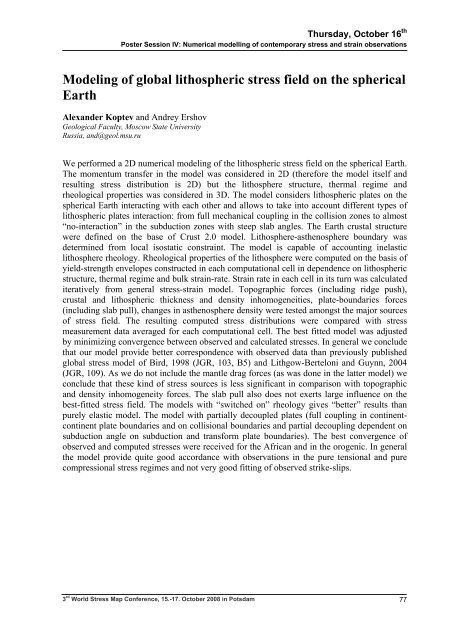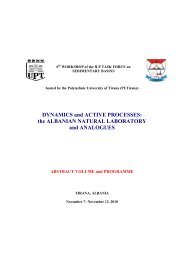World Stress Map Conference - International Lithosphere Program ...
World Stress Map Conference - International Lithosphere Program ...
World Stress Map Conference - International Lithosphere Program ...
You also want an ePaper? Increase the reach of your titles
YUMPU automatically turns print PDFs into web optimized ePapers that Google loves.
Thursday, October 16 th<br />
Poster Session IV: Numerical modelling of contemporary stress and strain observations<br />
Modeling of global lithospheric stress field on the spherical<br />
Earth<br />
Alexander Koptev and Andrey Ershov<br />
Geological Faculty, Moscow State University<br />
Russia, and@geol.msu.ru<br />
We performed a 2D numerical modeling of the lithospheric stress field on the spherical Earth.<br />
The momentum transfer in the model was considered in 2D (therefore the model itself and<br />
resulting stress distribution is 2D) but the lithosphere structure, thermal regime and<br />
rheological properties was considered in 3D. The model considers lithospheric plates on the<br />
spherical Earth interacting with each other and allows to take into account different types of<br />
lithospheric plates interaction: from full mechanical coupling in the collision zones to almost<br />
“no-interaction” in the subduction zones with steep slab angles. The Earth crustal structure<br />
were defined on the base of Crust 2.0 model. <strong>Lithosphere</strong>-asthenosphere boundary was<br />
determined from local isostatic constraint. The model is capable of accounting inelastic<br />
lithosphere rheology. Rheological properties of the lithosphere were computed on the basis of<br />
yield-strength envelopes constructed in each computational cell in dependence on lithospheric<br />
structure, thermal regime and bulk strain-rate. Strain rate in each cell in its turn was calculated<br />
iteratively from general stress-strain model. Topographic forces (including ridge push),<br />
crustal and lithospheric thickness and density inhomogeneities, plate-boundaries forces<br />
(including slab pull), changes in asthenosphere density were tested amongst the major sources<br />
of stress field. The resulting computed stress distributions were compared with stress<br />
measurement data averaged for each computational cell. The best fitted model was adjusted<br />
by minimizing convergence between observed and calculated stresses. In general we conclude<br />
that our model provide better correspondence with observed data than previously published<br />
global stress model of Bird, 1998 (JGR, 103, B5) and Lithgow-Berteloni and Guynn, 2004<br />
(JGR, 109). As we do not include the mantle drag forces (as was done in the latter model) we<br />
conclude that these kind of stress sources is less significant in comparison with topographic<br />
and density inhomogeneity forces. The slab pull also does not exerts large influence on the<br />
best-fitted stress field. The models with “switched on” rheology gives “better” results than<br />
purely elastic model. The model with partially decoupled plates (full coupling in continentcontinent<br />
plate boundaries and on collisional boundaries and partial decoupling dependent on<br />
subduction angle on subduction and transform plate boundaries). The best convergence of<br />
observed and computed stresses were received for the African and in the orogenic. In general<br />
the model provide quite good accordance with observations in the pure tensional and pure<br />
compressional stress regimes and not very good fitting of observed strike-slips.<br />
3 rd <strong>World</strong> <strong>Stress</strong> <strong>Map</strong> <strong>Conference</strong>, 15.-17. October 2008 in Potsdam<br />
77




